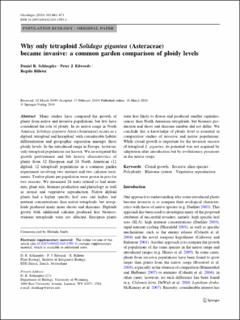Bitte benutzen Sie diese Kennung, um auf die Ressource zu verweisen:
https://doi.org/10.21256/zhaw-3853| Publikationstyp: | Beitrag in wissenschaftlicher Zeitschrift |
| Art der Begutachtung: | Peer review (Publikation) |
| Titel: | Why only tetraploid Solidago gigantea (Asteraceae) became invasive : a common garden comparison of ploidy levels |
| Autor/-in: | Schlaepfer, Daniel R. Edwards, Peter J. Billeter, Regula |
| DOI: | 10.21256/zhaw-3853 10.1007/s00442-010-1595-3 |
| Erschienen in: | Oecologia |
| Band(Heft): | 163 |
| Heft: | 3 |
| Seite(n): | 661 |
| Seiten bis: | 673 |
| Erscheinungsdatum: | 2010 |
| Verlag / Hrsg. Institution: | Springer |
| ISSN: | 0029-8549 1432-1939 |
| Sprache: | Englisch |
| Schlagwörter: | Asteraceae; Calcium; Diploidy; Europe; Genetic variation; Geography; Nitrogen; North America; Phosphorus; Plant shoot; Polyploidy; Soil; Biological evolution; Ecosystem; Ploidies |
| Fachgebiet (DDC): | 580: Pflanzen (Botanik) |
| Zusammenfassung: | Many studies have compared the growth of plants from native and invasive populations, but few have considered the role of ploidy. In its native range in North America, Solidago gigantea Aiton (Asteraceae) occurs as a diploid, tetraploid and hexaploid, with considerable habitat differentiation and geographic separation amongst these ploidy levels. In the introduced range in Europe, however, only tetraploid populations are known. We investigated the growth performance and life history characteristics of plants from 12 European and 24 North American (12 diploid, 12 tetraploid) populations in a common garden experiment involving two nutrient and two calcium treatments. Twelve plants per population were grown in pots for two seasons. We measured 24 traits related to leaf nutrients, plant size, biomass production and phenology as well as sexual and vegetative reproduction. Native diploid plants had a higher specific leaf area and higher leaf nutrient concentrations than native tetraploids, but tetraploids produced many more shoots and rhizomes. Diploids grown with additional calcium produced less biomass, whereas tetraploids were not affected. European plants were less likely to flower and produced smaller capitulescences than North American tetraploids, but biomass production and shoot and rhizome number did not differ. We conclude that a knowledge of ploidy level is essential in comparative studies of invasive and native populations. While clonal growth is important for the invasion success of tetraploid S. gigantea, its potential was not acquired by adaptation after introduction but by evolutionary processes in the native range. |
| URI: | https://digitalcollection.zhaw.ch/handle/11475/7753 |
| Volltext Version: | Publizierte Version |
| Lizenz (gemäss Verlagsvertrag): | Lizenz gemäss Verlagsvertrag |
| Departement: | Life Sciences und Facility Management |
| Organisationseinheit: | Institut für Umwelt und Natürliche Ressourcen (IUNR) |
| Enthalten in den Sammlungen: | Publikationen Life Sciences und Facility Management |
Dateien zu dieser Ressource:
| Datei | Beschreibung | Größe | Format | |
|---|---|---|---|---|
| Schlaepfer2010_Article_WhyOnlyTetraploidSolidagoGigan.pdf | 533.49 kB | Adobe PDF |  Öffnen/Anzeigen |
Zur Langanzeige
Schlaepfer, D. R., Edwards, P. J., & Billeter, R. (2010). Why only tetraploid Solidago gigantea (Asteraceae) became invasive : a common garden comparison of ploidy levels. Oecologia, 163(3), 661–673. https://doi.org/10.21256/zhaw-3853
Schlaepfer, D.R., Edwards, P.J. and Billeter, R. (2010) ‘Why only tetraploid Solidago gigantea (Asteraceae) became invasive : a common garden comparison of ploidy levels’, Oecologia, 163(3), pp. 661–673. Available at: https://doi.org/10.21256/zhaw-3853.
D. R. Schlaepfer, P. J. Edwards, and R. Billeter, “Why only tetraploid Solidago gigantea (Asteraceae) became invasive : a common garden comparison of ploidy levels,” Oecologia, vol. 163, no. 3, pp. 661–673, 2010, doi: 10.21256/zhaw-3853.
SCHLAEPFER, Daniel R., Peter J. EDWARDS und Regula BILLETER, 2010. Why only tetraploid Solidago gigantea (Asteraceae) became invasive : a common garden comparison of ploidy levels. Oecologia. 2010. Bd. 163, Nr. 3, S. 661–673. DOI 10.21256/zhaw-3853
Schlaepfer, Daniel R., Peter J. Edwards, and Regula Billeter. 2010. “Why Only Tetraploid Solidago Gigantea (Asteraceae) Became Invasive : A Common Garden Comparison of Ploidy Levels.” Oecologia 163 (3): 661–73. https://doi.org/10.21256/zhaw-3853.
Schlaepfer, Daniel R., et al. “Why Only Tetraploid Solidago Gigantea (Asteraceae) Became Invasive : A Common Garden Comparison of Ploidy Levels.” Oecologia, vol. 163, no. 3, 2010, pp. 661–73, https://doi.org/10.21256/zhaw-3853.
Alle Ressourcen in diesem Repository sind urheberrechtlich geschützt, soweit nicht anderweitig angezeigt.